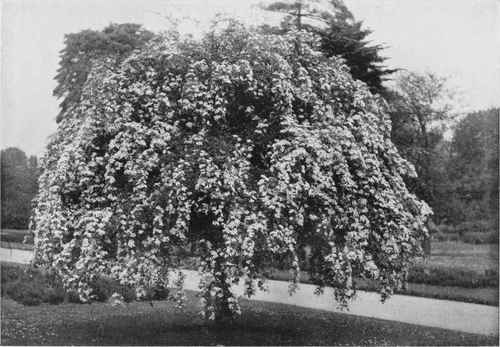Part 3. Chapter 14. Lawn Shrubs and Trees - Pendulous or Weeping Trees
Description
This section is from the book "Garden Trees and Shrubs", by Walter P. Wright. Also available from Amazon: Garden Trees And Shrubs Illustrated In Colour.
Part 3. Chapter 14. Lawn Shrubs and Trees - Pendulous or Weeping Trees
Introduction
Although all the principal shrubs and trees are described in Part 4., and their uses indicated, it is thought that selections of the best kinds, grouped for the various purposes to which they can be put, may be convenient to readers as affording a ready guide to those who have particular wants.
When the garden-maker is considering shrubs and trees in relation to the house, he cannot fail to see the value of groups and specimens on lawns; and the formation of lawn-borders is naturally followed by the planting of certain kinds, not entirely appropriate to the borders, on selected sites on the lawn itself. Such plantings have a rich and at the same time refined effect. They are good, too, for the objects planted, because the prominent positions which they occupy insure their receiving adequate attention. They have plenty of room, and care is devoted to the planting and pruning.

Fig. Lawn Plantings Have A Rich, And At The Same Time Refined Effect. Painted by Josephine Gundry.
We have already seen that the problem of planting hybrid Rhododendrons in the border sometimes proves insoluble, and these noble plants are assigned sites on the lawn, where special beds are made for them. In prominent positions such as this, only really good varieties should be planted, and they may be selected from those described in Part 4.
The old plan of forming special peat beds is not followed now where good loam is available, as it is found that this soil suits Rhododendrons well; nevertheless, they are peat-lovers, and in places where, owing to a limestone formation existing, soil has to be imported to make special beds, peat may be used in a mound above ground level.
The plants grow somewhat slowly, and either thick planting with subsequent thinning must be adopted - and close-planting of modern Rhododendrons is expensive, as the plants are far from cheap - or other plants associated with the young Rhododendrons to avert a scrappy effect. Liliums are much used for this purpose. If the Rhododendrons are set six feet apart, they will meet in due course, and give the massed effect which is generally seen; but the true shrub-lover will find great delight in good specimens thinly grown,which can develop into large bushes and be seen from all sides, as in the great Cornish gardens. Thus, many will prefer single plants to groups.
One's thoughts turn naturally to Conifers when material for lawn trees is sought for. Shapely trees of the beautiful Wellingtonia gigantea, the columnar Libocedrus decurrens, the handsome Pseudostuga (Abies) Douglasi, the quaint and tortuous Araucaria imbricata, the beautiful Picea nobilis glauca and other kinds mentioned in Chapter 17. come to mind. All these may be planted as individual trees in round beds at selected places. Others suitable for use in a similar way are Catalpa bignonioides, the Tulip Tree (Liriodendron tulipifera), Buddleia globosa, Picea pungens, and its pendulous and glaucous varieties, Taxodium sempervirens, RobiniaNeo-Mexicana, Cupressus macrocarpa, Picea pinsapo glauca, Cupressus Lawsoniana, Thuja dolabrata, Pinus Cembra, the Copper Beech, and the Mulberry.

Fig. Grace And Shade On The Sun-Scorched Grass. A good Weeping Birch. For description see Chapter 14., and Part 4., Section B. Photo by F. Mason Good.

Fig. A Weeping Thorn at Kew. Crataegus oxyacantha pendilla. For description see Part 4. Photo by R. A. Malby.
Smaller trees suitable for use on lawns are Paulownia imperialis, Ailanthus glandulosa, Retinosporas, varieties of Cryptomeria japonica, Cupressus Lawsoniana and Juniperus Virginiana.
The Pampas Grass is highly effective when well furnished with its white plumes in autumn.
Beds of hardy Azaleas will be equally as effective on the lawn as in the border.
Among the shrubs and trees used for lawns, a few kinds of pendulous habit, often spoken of as weepers, may be introduced. They have a graceful appearance, and impart a sense of variety. Nowhere in the garden do weeping trees look so well as on an expanse of turf, unless it be at the waterside.
When the tree-lover looks among the varieties of popular trees, such as the Ash, Birch, Poplar, Beech, Elm and Holly, he finds that there are many beautiful weeping forms, generally distinguished by the varietal name pendula. Thus, there is the weeping Ash, Fraxinus excelsior pendula; the weeping Aspen, Populus tremula pendula; the weeping Beeches, Fagus sylvatica pendula and F. s. Miltonensis; the weeping Silver Birches, Betula alba pendula and B. a. Youngii; the weeping Hollies, Ilex aquifolium pendula and Perrin's weeping variety; and the weeping Elms, Alnus montana pendula and A. campestris pendula.
Judgment should be exercised in lawn-planting, for it is easily overdone. There should be no planting at fixed intervals. A "spotty" effect is to be deprecated. The planting should be irregular. Nor should the greater part of the lawn be covered. On the contrary, there should be an effect of lawn relieved by trees and shrubs.
In the main, grouped shrubs should be in beds near the edge of the lawn, a few feet only from the path, and they should be on the part farthest from the house, so that an expanse of turf may intervene.
Continue to:


